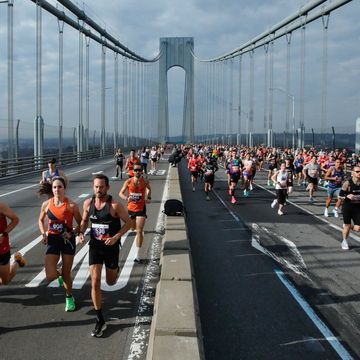If there’s one person who fits the mold for a textbook endurance athlete, it might be ultrarunner Camille Herron. You can’t miss her tall frame in races on the roads or the trails. She’s usually at the front of the pack, her blond hair hanging loose around her shoulders. While her competitors may be grimacing, Herron is most likely smiling. She just looks like she’s having fun—like there’s nothing she’d rather do than log mile after mile after mile.
Herron says she was born to run and her talent for long footraces has resulted in multiple American and world records, from 50-mile races to events that spanned 24 hours, world championship titles, and outright wins against all competitors. She even holds the Guinness World Record for the fastest marathon run by a woman in a superhero costume (she dressed as Spider-Man).
What makes Herron so good at ultrarunning is largely her physiology and, more specifically, her aerobic capacity. Her body is primed for high-volume training. In grad school, her VO2 max was measured in the high 60s, a level that indicates she has a pretty big aerobic engine. VO2 max is a proxy for the maximum amount of oxygen you’re able to take up and pump to your muscles and is one of the three factors that does a pretty good job of predicting performance in endurance sports.
While Herron hasn’t had her muscles biopsied, she says she believes she’s made up of “probably like 99 percent slow-twitch” muscle fibers—the ones that power athletes through long, steady-state exercise and are less prone to muscular fatigue. Unsurprisingly, the ability to withstand fatigue can be a pivotal factor in whether an athlete crosses the finish line. And women, on average, tend to have a greater distribution of slow-twitch, or type I, muscle fibers.
On the whole, these fibers are suffused with capillaries, the tiny blood vessels that carry oxygenated blood. They have more mitochondria too, the cell’s energy powerhouse. That means slow-twitch fibers have everything they need to keep going and going…and going.
Men, on the other hand, have a greater proportion of fast-twitch or type II fibers, which are better suited for speed and powerful bursts of movement, in part explaining men’s historic dominance in traditional sports. But with a lower concentration of capillaries and mitochondria, these muscle fibers also tucker out faster.
Sandra Hunter, director of the Athletic and Human Performance Research Center at Marquette University, has spent the better part of the last 20 years studying muscle function in women and creating models to explain why muscles are susceptible to fatigue.
In the lab, she has observed that women tire less quickly during specific kinds of exercise. For example, she asked women and men volunteers to perform intermittent, static muscle contractions—repeatedly engaging their arm muscles at 50 percent of their maximum strength for six seconds, then resting for four seconds, until they were exhausted. The men quit the steady-state activity after an average of 8.5 minutes while the women lasted approximately 23.5 minutes—nearly three times longer.
Hunter says the discrepancies aren’t due to a person’s motivation or ability to activate their muscles. Instead, she says it comes down to the distinct composition of muscle fibers, and women have fibers that don’t fatigue as fast. But Hunter says the greater muscle mass and muscle fiber diameter found in men might play a role too. When these stronger muscles are engaged, they might exert more pressure inside the muscle. The rise in internal pressure could restrict or cut off blood flow and oxygen, which would cause the muscle to tire quickly.
Other studies in the field have found that women accumulated less waste product and blood lactate in their muscles, which may also contribute to their ability to withstand fatigue.
While interesting, these findings don’t really tell us much about what might happen in the real world. In 2012, a team of Canadian and French researchers set out to determine if women were still more resistant to fatigue after an actual ultra-endurance exercise session.
They recruited 10 men and 10 women who were participating in the Ultra-Trail du Mont-Blanc (UTMB) in the Alps, the Super Bowl of the ultrarunning world. After the 110-kilometer race (the normally 171-kilometer course was shortened due to wintery conditions), the muscles in the men’s calves and thighs were more exhausted compared to the women. The finding confirmed what Hunter saw in her lab: Women tire less than men after long, steady-state physical activity.
Aerobic capacity and muscle endurance are only part of the physiology puzzle. Another key factor in an athlete’s success is how well their body uses carbohydrates and fat for fuel. While carbohydrates are a readily available source of energy for most activities, the body simply can’t store enough carbs to keep an athlete going for extended periods of time. At some point, it must turn to fat to power working muscles, and the ability to burn fat efficiently matters in ultra-endurance sports.
Herron has a preternatural awareness of her body’s energy and hydration needs, rarely dipping into a depleted state where her body is using more energy than she’s taking in. While most people weigh less after a race because of the number of calories they expend and water weight lost through sweat, Herron says she often weights the same, even after a 24-hour race. She’s never skipped her period either, a critical marker of hormonal and bone health linked to adequate nutrition. Herron thinks it’s partly because her body is “probably wired for fat metabolism.”
If an athlete is more adept at accessing and burning fat, their body may be better primed to sustain longer bouts of aerobic exercise because, theoretically, they won’t run out of gas as quickly. Fat, with its greater energy density, offers a bigger bang for the buck compared to carbohydrates.
Evidence suggests that women are more metabolically nimble, capable of switching from burning carbohydrates to burning fat, especially during the second half of the menstrual cycle. It turns out that women have more of a specific enzyme needed to facilitate the breakdown of long and medium fatty acid chains. Compared to men, women break down and metabolize fat at a rate that’s up to 56 percent greater over a 24-hour period, regardless of physical activity level. Even at submaximal efforts typical of endurance events, some research suggests that men use as much as 25 percent more of their stored carbohydrates.
Nicholas Tiller, an exercise physiologist who studies how the body responds to extreme endurance exercise and an ultramarathon runner himself, says this ability to utilize fat efficiently has “knock-on implications.” To keep moving forward, ultra-athletes must keep their bodies regularly topped off with calories.
Overall, women ultra-athletes don’t need to take in as many calories compared to men because of their smaller body mass. By not ingesting as much food, gels, bars, and sports drinks, women potentially dodge a bullet when it comes to meddlesome gastrointestinal issues like cramping, vomiting, nausea, loose stools, and bloating, which are frequently cited as one of the top two reasons athletes drop out of a race or don’t perform as well as expected. Plus, if an athlete utilizes fat for energy, like women seem to do, they can reduce the risk of glycogen depletion—when they’ve used up their critical stores of carbohydrates and hit the dreaded “wall.”
Both Hunter and Tiller caution that when it comes to sex-based differences in endurance sports, more research is needed. It’s an area of study that scientists continue to tease apart. While some studies show a definitive effect, others report no significant findings.
In part, it’s because carrying out research on endurance sports, particularly with women athletes, is hard. For studies conducted in laboratories, scientists often default to men as participants due to factors like the complications (and costs) related to controlling for the menstrual cycle. With field studies, scientists have a hard time getting people to participate in general. “They’ve been training all year for one race. They don’t want to potentially compromise or sacrifice their race performance to help out someone who’s doing some research,” Tiller says.
Lower participation rates of women in races make it even harder to recruit these athletes. With fewer (or no) women taking part in studies, scientists can’t examine direct sex differences.
Since ultra-races often take place on high-alpine trails, in desert landscapes, and on other difficult terrain, scientists must consider the event’s locations and logistics—and how that might affect data collection. If races occur in remote environments, it could be anywhere from an hour to a day or more for athletes to travel from the finish line to a lab. “At that point, there’s no point taking any measurements because any of the acute, short-term effects are going to have worn off. You need to take these measurements as close to the finish line as possible,” Tiller says.
In his studies, Tiller has done everything from camping out in the field for 10 days to conducting tests with athletes in the back of a bus while traveling from the finish line back to base camp. He laughs as he describes what’s supposed to be high-level scientific research. It also influences the type of measurements scientists can collect in the field. It’s relatively easy to measure blood pressure and heart rate, take blood samples, and perform breathing tests. However, he says, these are superficial tests and “none of this is giving us a lot of information about how the body is responding” like CT scans might provide.
While there are some compelling reasons for women’s success in ultra-endurance activities, researchers are still on the hunt for the X factor. As physiological advantages begin to fade away with longer distances, athletes say the psychology of sports and mental stamina begins to take on more importance.
It’s clear that endurance is far from straightforward. There is a complex array of factors, and at times it can feel like you’re shuffling a card deck, hoping you’re dealt a winning hand on race day. But what research and athletes themselves continue to discover is that a winning hand doesn’t look the same for women and men, especially for extreme distance events. Those winning hands may include a wider, more varied combination of cards.
In the case of women, they may even include cards from the discard pile that no one thought to consider before. When we start to expand the model of athletic performance beyond the traditional male framework, we add more cards to the deck, reframing what is possible for all people.
From UP TO SPEED: The Groundbreaking Science of Women Athletes by Christine Yu, published by Riverhead Books, an imprint of Penguin Publishing Group, a division of Penguin Random House, LLC. Copyright © 2023 by Christine Yu.

Christine Yu is an award-winning journalist and author of the book Up to Speed: The Groundbreaking Science of Women Athletes. Her work focuses on the intersection of sports science and women athletes. She's a lifelong athlete who loves running, yoga, surfing, and skiing.














